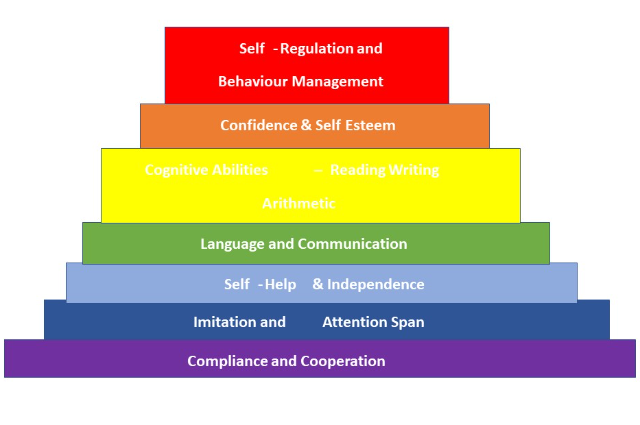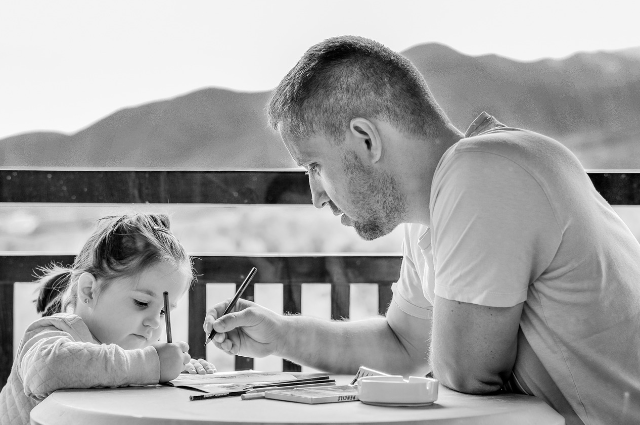
Parents of neurodiverse children, despite their challenges in navigating diverse special needs parenting, wish for a successful mainstream life for their children. We all want our children to be part of a mainstream society.
Successful mainstream and inclusion is a step-by-step, gradual but consistent endeavor that parents must learn to navigate with patience, strength, and correct attitude. I devised a rainbow approach to Mainstream education and inclusion for my son for the past 11 years, which stood us in good stead in all the trying times.
Come, let's try and employ at least one if not all the 7 Domains of intervention in the Rainbow Approach.
Rainbow Approach to Parent Intervention – The 7 Domains to Target.
Let’s understand each of these domains one by one...
1. Compliance and Cooperation:
All children work for reinforcement. The reinforcement can be edible, tangible, sensory, verbal or a token like a star or a tally mark. Many children do not understand reinforcement or the concept of fun, so the first step is to teach them the concept of fun and reinforcement. The starting point for earning compliance and cooperation is by offering reinforcement. If you do not have any idea about what reinforcement your child responds to, then start by giving him three to five options, one day at a time.
You can also have tangible reinforcers like his favourite toy, his favourite outing (which is park usually), his favourite activity (for example rocking horse or swing), or something sensory for example a head massage, a hand squeeze, water play, sand play, shaving foam play, modeling clay.
2. Imitation and Attention Span
Although these are two separate categories, I club them together because while executing, they work in tandem. The very first activity to start with is Hi-Five, moving to Hi-10.
The command to give: <Name of the child> DO THIS. Show him a Hi-Five, if he does it bring your hand closer to his and give him a Hi-Five followed by a reinforcer.
If the child does not imitate, manually help him to adopt the hi-five stance and bring your hand closer to his to complete the task.
You can use many more actions like waving, hands together, clapping, folding hands, wriggling fingers, and incy wincy spider. Many rhymes can be incorporated with actions to engage your child in imitation and attention span.
The next cluster of activities is of his daily life, using an empty cup, giving the command “do this” followed by the action of drinking from the cup, encouraging him to do the same with his cup. Similarly with combing hair, brushing teeth, and wiping hands/face with a towel.
The third cluster is simple gross motor exercises like jumping, marching, lunging, cross crawling, bending forward or bending sideways. A variety of gross motor tasks can be adopted with the command ‘Do this’.
The fourth cluster is tabletop activities like puzzles, spooning grain from one bowl to another, sponging water from one bowl to another, picking up cotton wool and putting it into an empty cola pet bottle (that has a small mouth), taking a clothes peg and clip it onto a cardboard.
These are some of the activities that will help your child learn to imitate you and maintain an attention span which will gradually increase by the time spent in completing more repetitions of the activity.
3. Self-help and Independence
Always start from where your child is at. Commend your child for being where they are, the attitude of gratitude makes us go a long way. Our children feel loved and accepted for who they are and not for what they need to become. Starting from where your child is, gradually start helping them get further skills. Among the most important self-help skills is, self-feeding, first with finger foods then with a spoon with minimal mess. The second most important skill is selfdressing, always start first by pulling up pants, pulling up socks, pulling down a shirt when you have made them wear it, etc. From there you gradually move to more complex tasks like putting on pants, socks, and a shirt in that order. The third most important skill is toilet training. Why I don’t put it first is because in my experience most parents with neurodiverse children struggle in this area, and many children get toilet trained by the time they turn seven or eight. And it's ok. We have to go at the child’s pace. Among the more complex self-help and independence skills are expressing needs, distress, and simple emotions like happy, sad, angry, and upset.
4. Language and Communication
Language has two components, receptive and expressive language. For expressive language, activities of vocal imitation are useful. Start with simple activities like a phonic drill, labeling the environment, and going to ‘I need statements’ like I need water or I need to go to the toilet. For receptive language, you can start by discussing functions of daily use items like ‘This is a toothbrush, we use it for brushing our teeth like this.’ Similarly ‘this is soap, we use it for bathing like this’.
Stage two You may place a cup and a brush on the table and say ‘Show me a tooth brush’ When the child picks up the toothbrush you can ask, what do we do with it? Finally, in stage three you may place a cup, a toothbrush, and a comb and ask them (pointing at the comb) “What is this?” if the child answers comb, ask, what do we do with it? It is essential for parents to know that the journey from stage one to stage three can take time and each child has a unique pattern of learning so at all times, go at the pace of the child.
5. Academics: Reading – Writing – Arithmetic
Begin by recognizing your child's unique strengths and challenges, fostering a sense of belonging. Employ multi-sensory techniques, incorporating visual aids, auditory cues, and tactile experiences to accommodate diverse learning styles. For teaching reading, focus on individualized phonics instruction, using colorful and engaging materials to enhance comprehension. Utilize repetitive activities and interactive games to reinforce letter recognition and sound associations.
When teaching writing, encourage fine motor development through activities like drawing, tracing, and crafting. Implement adaptive tools such as grips or specialized writing instruments to support children with motor coordination difficulties. Emphasize the joy of self-expression, fostering a positive attitude towards the written word.
In arithmetic, use concrete materials like counting beads or manipulatives to make abstract concepts tangible. Break down tasks into manageable steps, offering visual aids and simplified language to aid understanding. Celebrate small victories, nurturing a sense of accomplishment and boosting self-esteem.
6. Confidence and Self-Esteem
Fostering confidence and self-esteem in neurodiverse children requires a nurturing and individualized approach. Begin by establishing a safe and accepting environment that values your child's unique strengths. Celebrate their achievements, no matter how small, to instill a sense of pride and accomplishment. Encourage positive self-identity by incorporating inclusive materials that reflect diverse experiences and abilities. Use visual supports, social stories, and role-playing activities to enhance social understanding and boost self-confidence. Provide clear and consistent expectations while recognizing and reinforcing positive behaviors to build a sense of competence. Allow flexibility in learning styles, offering alternatives for communication and expression. Emphasize the importance of self-advocacy, teaching children to express their needs and preferences, empowering them to navigate the world with confidence.
7. Self Regulation and Behaviour Management
Parents play a crucial role in creating an environment that supports the development of self-regulatory skills. Begin by establishing predictable routines, and providing a structured daily schedule that includes clear transitions and visual cues, helping neurodiverse children anticipate and navigate changes. Teach explicit self-regulation strategies through social stories, visual prompts, and sensory tools. Help children identify and express their emotions, fostering a sense of self-awareness. Introduce calming techniques such as deep breathing exercises or sensory breaks to empower them with tools to manage emotional states effectively. Some effective calming activities that I was successful with were head press or head massage, body press or body squeezes, like a self hug, hand press or hand massage. Commands like ‘hands together’ are far more concrete than ‘behave yourself’. Children don’t know exactly what ‘behave yourself means’ so tell them what you exactly want and not what you don’t want. Instead of saying “Stop crying” you can sing “Can you do this just like me” and do some actions that may distract the child away from their distress. Sometimes offering them food helps regulate their behaviour, and at other times, letting them have some time to destress themselves works. At no cost will we take away their dignity and right to be upset?
Conclusion

Image by Daniela Dimitrova from Pixabay
As parents embark on the journey of preparing their children, specifically neurodiverse children for preschool, it's crucial to prioritize holistic development. Encourage social skills, self-regulation, and confidence. Create a supportive home environment mirroring the school's inclusive ethos. Foster open communication with educators, ensuring a consistent approach. Celebrate your child's unique strengths and collaborate with teachers to build a strong foundation for a positive and successful preschool experience, affirming that diversity is an asset in their educational journey.
